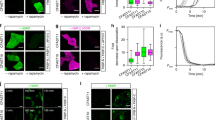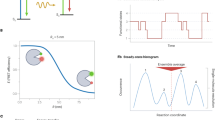Abstract
The analysis of structure and dynamics of biomolecules is important for understanding their function. Toward this aim, we introduce a method called 'switchable FRET', which combines single-molecule fluorescence resonance energy transfer (FRET) with reversible photoswitching of fluorophores. Typically, single-molecule FRET is measured within a single donor-acceptor pair and reports on only one distance. Although multipair FRET approaches that monitor multiple distances have been developed, they are technically challenging and difficult to extend, mainly because of their reliance on spectrally distinct acceptors. In contrast, switchable FRET sequentially probes FRET between a single donor and spectrally identical photoswitchable acceptors, dramatically reducing the experimental and analytical complexity and enabling direct monitoring of multiple distances. Our experiments on DNA molecules, a protein-DNA complex and dynamic Holliday junctions demonstrate the potential of switchable FRET for studying dynamic, multicomponent biomolecules.
This is a preview of subscription content, access via your institution
Access options
Subscribe to this journal
Receive 12 print issues and online access
$259.00 per year
only $21.58 per issue
Buy this article
- Purchase on Springer Link
- Instant access to full article PDF
Prices may be subject to local taxes which are calculated during checkout





Similar content being viewed by others
References
Selvin, P. & Ha, T. (eds). Single Molecule Techniques: A Laboratory Manual 1st edn. (Cold Spring Harbor Laboratory Press, Cold Spring Harbor, New York, 2008).
Kapanidis, A.N. & Strick, T. Biology, one molecule at a time. Trends Biochem. Sci. 34, 234–243 (2009).
Roy, R., Hohng, S. & Ha, T. A practical guide to single-molecule FRET. Nat. Methods 5, 507–516 (2008).
Gadella, T. (ed.). FRET and FLIM Techniques 1st edn. (Elsevier, London, 2009).
Clegg, R.M. Fluorescence resonance energy transfer and nucleic acids. Methods Enzymol. 211, 353–388 (1992).
Kapanidis, A.N. et al. Fluorescence-aided molecule sorting: Analysis of structure and interactions by alternating-laser excitation of single molecules. Proc. Natl. Acad. Sci. USA 101, 8936–8941 (2004).
Muschielok, A. et al. A nano-positioning system for macromolecular structural analysis. Nat. Methods 5, 965–971 (2008).
Hohng, S., Joo, C. & Ha, T. Single-molecule three-color FRET. Biophys. J. 87, 1328–1337 (2004).
Clamme, J.-P. & Deniz, A.A. Three-color single-molecule fluorescence resonance energy transfer. ChemPhysChem 6, 74–77 (2005).
Lee, N.K. et al. Three-color alternating-laser excitation of single molecules: monitoring multiple interactions and distances. Biophys. J. 92, 303–312 (2007).
Bates, M., Blosser, T.R. & Zhuang, X. Short-range spectroscopic ruler based on a single-molecule optical switch. Phys. Rev. Lett. 94, 108101 (2005).
Heilemann, M., Margeat, E., Kasper, R., Sauer, M. & Tinnefeld, P. Carbocyanine dyes as efficient reversible single-molecule optical switch. J. Am. Chem. Soc. 127, 3801–3806 (2005).
Rust, M.J., Bates, M. & Zhuang, X. Sub-diffraction-limit imaging by stochastic optical reconstruction microscopy (STORM). Nat. Methods 3, 793–795 (2006).
Heilemann, M. et al. Subdiffraction-resolution fluorescence imaging with conventional fluorescent probes. Angew. Chem. Int. Edn Engl. 47, 6172–6176 (2008).
Mao, S. et al. Optical lock-in detection of FRET using synthetic and genetically encoded optical switches. Biophys. J. 94, 4515–4524 (2008).
Jares-Erijman, E.A. & Jovin, T.M. FRET imaging. Nat. Biotechnol. 21, 1387–1395 (2003).
Vogelsang, J., Cordes, T., Forthmann, C., Steinhauer, C. & Tinnefeld, P. Controlling the fluorescence of ordinary oxazine dyes for single-molecule switching and superresolution microscopy. Proc. Natl. Acad. Sci. USA 106, 8107–8112 (2009).
Heilemann, M., van de Linde, S., Mukherjee, A. & Sauer, M. Super-resolution imaging with small organic fluorophores. Angew. Chem. Int. Edn. Engl. 48, 6903–6908 (2009).
Lee, N.K. et al. Accurate FRET measurements within single diffusing biomolecules using alternating-laser excitation. Biophys. J. 88, 2939–2953 (2005).
Wozniak, A.K., Schröder, G.F., Grubmüller, H., Seidel, C.A. & Oesterhelt, F. Single-molecule FRET measures bends and kinks in DNA. Proc. Natl. Acad. Sci. USA 105, 18337–18342 (2008).
Margeat, E. et al. Direct observation of abortive initiation and promoter escape within single immobilized transcription complexes. Biophys. J. 90, 1419–1431 (2006).
Rasnik, I., McKinney, S.A. & Ha, T. Nonblinking and long-lasting single-molecule fluorescence imaging. Nat. Methods 3, 891–893 (2006).
Mekler, V. et al. Structural organization of bacterial RNA polymerase holoenzyme and the RNA polymerase-promoter open complex. Cell 108, 599–614 (2002).
Clegg, R.M., Murchie, A.I., Zechel, A. & Lilley, D.M. Observing the helical geometry of double-stranded DNA in solution by fluorescence resonance energy transfer. Proc. Natl. Acad. Sci. USA 90, 2994–2998 (1993).
Holden, S.J. et al. Defining the limits of single-molecule FRET resolution in TIRF microscopy. Biophys. J. (in the press).
Lawson, C.L. et al. Catabolite activator protein: DNA binding and transcription activation. Curr. Opin. Struct. Biol. 14, 10–20 (2004).
Napoli, A.A., Lawson, C.L., Ebright, R.H. & Berman, H.M. Indirect readout of DNA sequence at the primary-kink site in the CAP-DNA complex: recognition of pyrimidine-purine and purine-purine steps. J. Mol. Biol. 357, 173–183 (2006).
Kapanidis, A.N., Ebright, Y.W., Ludescher, R.D., Chan, S. & Ebright, R.H. Mean DNA bend angle and distribution of DNA bend angles in the CAP-DNA complex in solution. J. Mol. Biol. 312, 453–468 (2001).
Karymov, M., Daniel, D., Sankey, O.F. & Lyubchenko, Y.L. Holliday junction dynamics and branch migration: Single-molecule analysis. Proc. Natl. Acad. Sci. USA 102, 8186–8191 (2005).
McKinney, S.A., Joo, C. & Ha, T. Analysis of single-molecule FRET trajectories using hidden Markov modeling. Biophys. J. 91, 1941–1951 (2006).
Santoso, Y. et al. Conformational transitions in DNA polymerase I revealed by single-molecule FRET. Proc. Natl. Acad. Sci. USA 107, 715–720 (2010).
Heilemann, M., Hwang, L.C., Lymperopoulos, K. & Kapanidis, A.N. Single-molecule FRET analysis of protein-DNA complexes. Methods Mol. Biol. 543, 503–521 (2009).
Kapanidis, A.N. et al. Alternating-laser excitation of single molecules. in Single Molecule Techniques: A Laboratory Manual 1st edn. (eds. Selvin, P. & Ha, T.) 85–119 (Cold Spring Harbor Laboratory Press, 2008).
Cordes, T., Vogelsang, J. & Tinnefeld, P. On the mechanism of Trolox as antiblinking and antibleaching reagent. J. Am. Chem. Soc. 131, 5018–5019 (2009).
Irwin, M. Detectors and data analysis techniques for widefield optical imaging. in Instrumentation for Large Telescopes: VIIth Canary Islands Winter School of Astrophysics 35–74 (1997) (Cambridge University Press, New York, 1997).
Crocker, J.C. & Grier, D.G. Methods of digital video microscopy for colloidal studies. J. Colloid Interface Sci. 179, 298–310 (1996).
Deniz, A.A. et al. Single-pair fluorescence resonance energy transfer on freely diffusing molecules: Observation of Förster distance dependence and subpopulations. Proc. Natl. Acad. Sci. USA 96, 3670–3675 (1999).
Norman, D.G., Grainger, R.J., Uhrin, D. & Lilley, D.M.J. Location of cyanine-3 on double-stranded DNA: importance for fluorescence resonance energy transfer studies. Biochemistry 39, 6317–6324 (2000).
Cooper, M. et al. Cy3B: Improving the performance of cyanine dyes. J. Fluoresc. 14, 145–150 (2004).
Gell, C., Brockwell, D. & Smith, A. Handbook of Single Molecule Fluorescence Spectroscopy (Oxford University Press, 2006).
Dale, R.E., Eisinger, J. & Blumberg, W.E. The orientational freedom of molecular probes. Biophys. J. 26, 161–193 (1979).
Berney, C. & Danuser, G. FRET or no FRET: A quantitative comparison. Biophys. J. 84, 3992–4010 (2003).
Daigle, O., Carignan, C. & Blais-Ouellette, S. Faint flux performance of an EMCCD. Proc. SPIE. 6276, 62761–62767 (2006).
Thompson, R.E., Larson, D.R. & Webb, W.W. Precise nanometer localization analysis for individual fluorescent probes. Biophys. J. 82, 2775–2783 (2002).
Kapanidis, A.N., Ebright, Y.W. & Ebright, R.H. Site-specific incorporation of fluorescent probes into protein: Hexahistidine-tag-mediated fluorescent labeling using (Ni2+:Nitrilotriacetic acid)n-fluorochrome conjugates. J. Am. Chem. Soc. 123, 12123–12125 (2001).
McKinney, S.A., Déclais, A.-C., Lilley, D.M. & Ha, T. Structural dynamics of individual Holliday junctions. Nat. Struct. Biol. 10, 93–97 (2003).
Acknowledgements
We thank K. Gryte, J. Hohlbein, T.M.C. Rito and A. Riegert for technical and editorial assistance, and M. Leake for suggestions. S.U., S.J.H., L.L.R., J.P. and A.N.K. were supported by a UK Bionanotechnology Interdisciplinary Research Collaboration grant, Engineering and Physical Science Research Council grant EP/D058775 and European Community Seventh Framework Programme (FP7/2007-2013) grant HEALTH-F4-2008-201418 (entitled READNA). S.U. was supported by the German National Academic Foundation and the company SAP AG. M.H. and S.v.d.L. were supported by the Systems Biology Initiative (Forschungseinheiten der Systembiologie) of the German Ministry of Research and Education (0315262).
Author information
Authors and Affiliations
Contributions
S.U., M.H. and A.N.K. designed research; S.U. performed experiments and simulations; S.U. and S.J.H. analyzed data; L.L.R. built experimental setup; S.U., J.P. and S.v.d.L. prepared reagents; S.U. and A.N.K. wrote manuscript; and S.U., S.J.H., L.L.R., J.P., S.v.d.L., M.H. and A.N.K. discussed results and commented on the manuscript.
Corresponding author
Ethics declarations
Competing interests
The authors declare no competing financial interests.
Supplementary information
Supplementary Text and Figures
Supplementary Figures 1–8 and Supplementary Tables 1–4 (PDF 2273 kb)
Rights and permissions
About this article
Cite this article
Uphoff, S., Holden, S., Le Reste, L. et al. Monitoring multiple distances within a single molecule using switchable FRET. Nat Methods 7, 831–836 (2010). https://doi.org/10.1038/nmeth.1502
Received:
Accepted:
Published:
Issue Date:
DOI: https://doi.org/10.1038/nmeth.1502
This article is cited by
-
Absolute measurement of cellular activities using photochromic single-fluorophore biosensors and intermittent quantification
Nature Communications (2022)
-
Two-colour single-molecule photoinduced electron transfer fluorescence imaging microscopy of chaperone dynamics
Nature Communications (2021)
-
Simultaneous readout of multiple FRET pairs using photochromism
Nature Communications (2021)
-
Intermolecular distance measurement with TNT suppressor on the M13 bacteriophage-based Förster resonance energy transfer system
Scientific Reports (2019)
-
Ensemble multicolour FRET model enables barcoding at extreme FRET levels
Nature Nanotechnology (2018)



